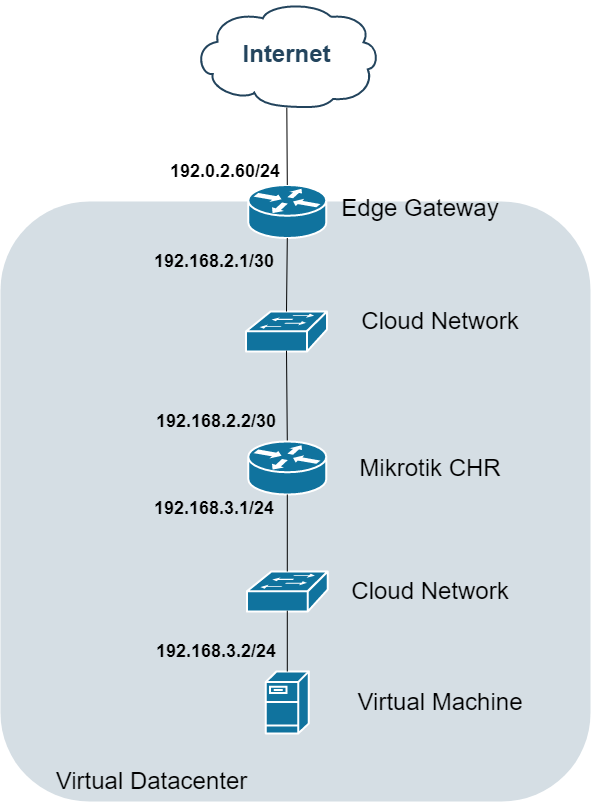Варианты, перечисленные ниже, не являются единственно возможными. Перечислены только наиболее популярные.
Условные обозначения:
Голубая рамка – граница Virtual Datacenter.
Virtual Machine – виртуальная машина. Также, может рассматриваться как группа виртуальных машин, подключенных в одну сеть.
Cloud Network – виртуальный коммутатор. Сети, создаваемые через интерфейс VMware Cloud Director в разделе Networks.
Edge Gateway – виртуальный маршрутизатор, размещенный на границе между VDC и Интернет. Помимо маршрутизации, выполняет функции Firewall и NAT.
Адреса из сети 192.168.0.0/16 являются частными в соответствии с RFC1918.
Адреса из сетей 192.0.2.0/24 и 198.51.100.0/24, используемые на примерах ниже, являются глобально маршрутизируемыми в соответствии с RFC5737.
Вариант 1. Классический
Подобным образом сеть конфигурируется автоматически при предоставлении тестового доступа.
На Edge Gateway назначен 1 глобально маршрутизируемый адрес.
Виртуальные машины подключены в сеть с приватными адреса (RFC1918) и взаимодействуют с хостами в Интернет через NAT на Edge Gateway.

Вариант 2. Несколько IP на Edge Gateway
На Edge Gateway назначено 2 глобально маршрутизируемых адреса.
Виртуальные машины подключены в сеть с приватными адреса (RFC1918) и взаимодействуют с хостами в Интернет через NAT на Edge Gateway.
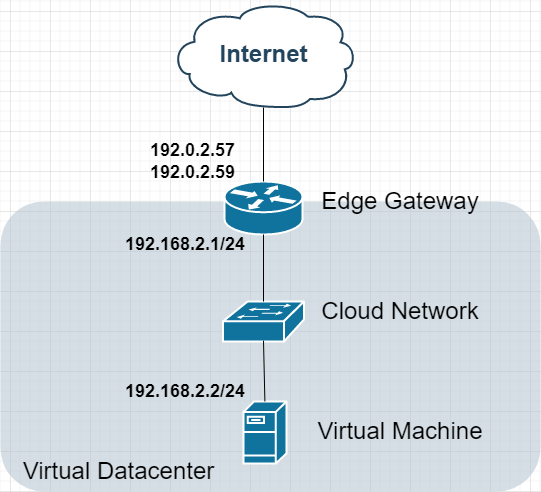
Вариант 3. Несколько сетей
На Edge Gateway назначен 2 глобально маршрутизируемых адреса.
Виртуальные машины подключены в сети с приватными адреса (RFC1918) и взаимодействуют с хостами в Интернет через NAT на Edge Gateway.
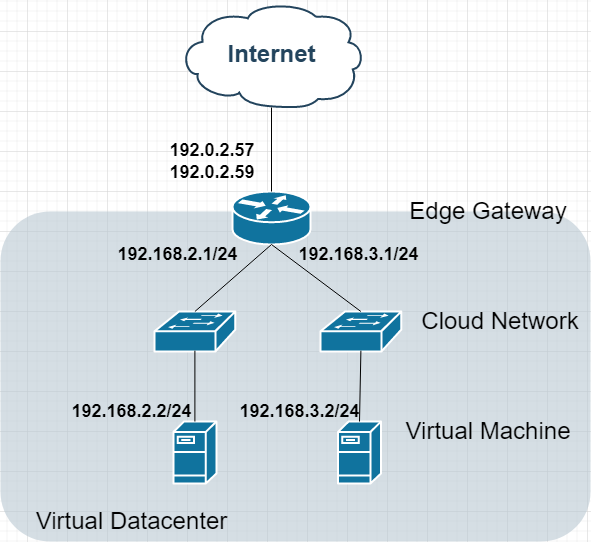
Вариант 4. Несколько Edge Gateway
В VDC развернуто 2 Edge Gateway.
На первый Edge Gateway назначено 2 глобально маршрутизируемых адреса.
На второй Edge Gateway назначен 1 глобально маршрутизируемый адрес.
Виртуальные машины подключены в сети с приватными адреса (RFC1918) и взаимодействуют с хостами в Интернет через NAT на Edge Gateway.
В сети 192.168.2.0/24 и 192.168.3.0/24 подключены разные Edge Gateway.
В случае, если виртуальным машинам 192.168.2.2 и 192.168.3.2 требуется взаимодействовать друг с другом по глобально маршрутизируемым адресам, этот Вариант предпочтительнее, чем использование Hairpin NAT на Edge Gateway, с точки зрения организации правил Firewall/NAT.
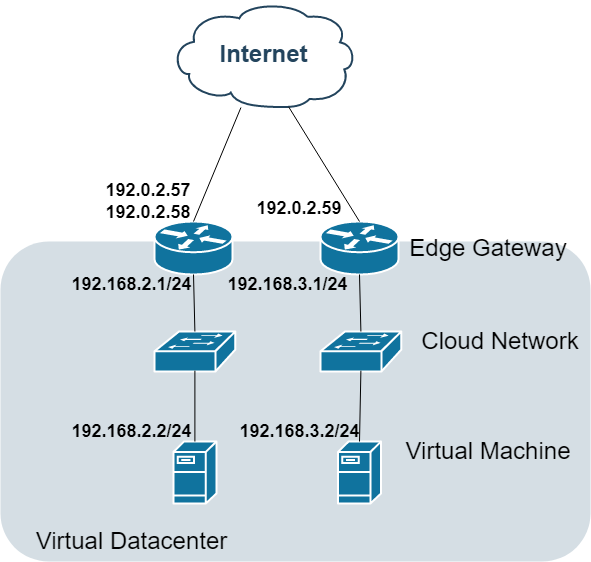
Вариант 5. Глобально маршрутизируемые IP
Данный Вариант предназначен для назначения глобально маршрутизируемых IP адресов на сетевые интерфейсы виртуальных машин без использования NAT на Edge Gateway.
Это может быть полезно, если какой-либо протокол не работает через NAT должным образом или Вы хотите развернуть другой виртуальный роутер, например Cisco CSR, Mikrotik CHR, Juniper SRX и т.п. или Вы хотите исключить NAT для удобства администрирования.
Мы предоставляем глобально маршрутизируемые IP адреса подсетями: /30, /29, /28 и более (в сторону увеличения количества адресов в подсети).
На схеме ниже предоставлена подсеть /30.
Предоставлено 5 адресов: /30 подсеть и еще 1 адрес назначен на Edge Gateway.
Назначение адресов может быть выполнено следующим образом:
198.51.100.0 – адрес подсети (служебный, нельзя назначить на сетевой интерфейс)
198.51.100.1 – назначен на внутренний интерфейс Edge Gateway (служебный, нельзя назначить на сетевой интерфейс)
198.51.100.2 – свободный адрес (можно назначить на сетевой интерфейс)
198.51.100.3 – широковещательный адрес (служебный, нельзя назначить на сетевой интерфейс)
192.0.2.60 – назначен на внешний интерфейс Edge Gateway. Может быть использован через NAT (как описано в Варианте 1). Удалить нельзя, используется как Nexthop для сети 198.51.100.0/30
Запрос на предоставление подсети осуществляется через обращение в техническую поддержку с указанием желаемого префикса (размера) подсети.
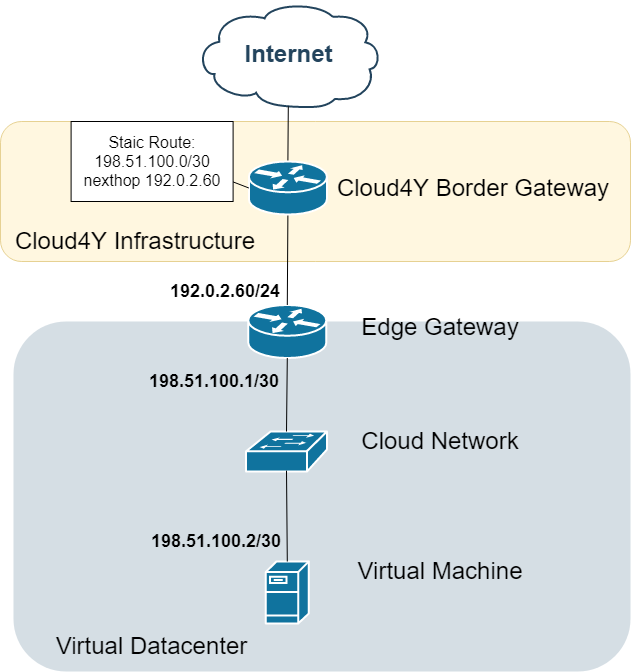
Важно: изменить адресацию уже созданной Cloud Network невозможно. Для изменения адресации, сеть необходимо отключить от всех VM, удалить, создать новую сеть с правильный адресаций. Это особенно критично, когда речь идет о сети с глобально маршрутизируемыми IP адресами.
Для минимизации времени простоя сервиса при изменении размеров/адресации подсети, мы рекомендуем заранее планировать количество IP адресов и приобретать сеть необходимого размера.
Вариант 6. Виртуальный роутер через NAT
Для развертывания виртуального роутера, вместо Edge Gateway, не обязательно приобретать подсеть глобально маршрутизируемых адресов. Можно ограничиться использованием NAT, если планируемая Вами инфраструктура позволяет такое использование.
Пример изображен на схеме ниже. В качестве виртуального роутера на схеме изображен Mikrotik CHR.
